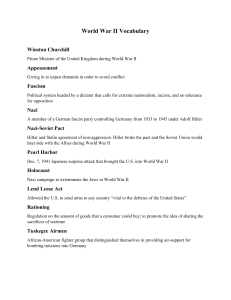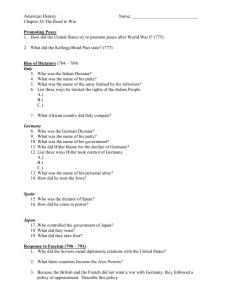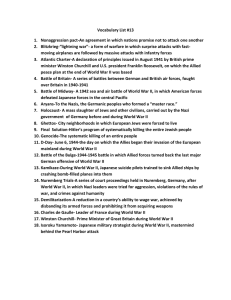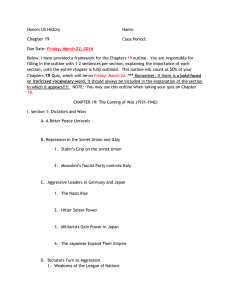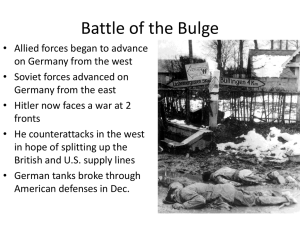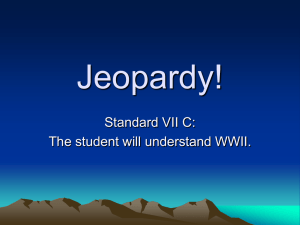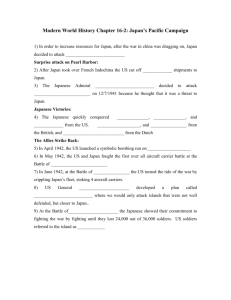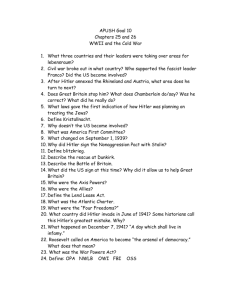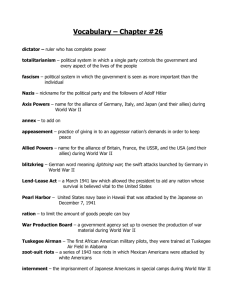Winning World War II (completed notes) A. US Alliance w/Great
advertisement
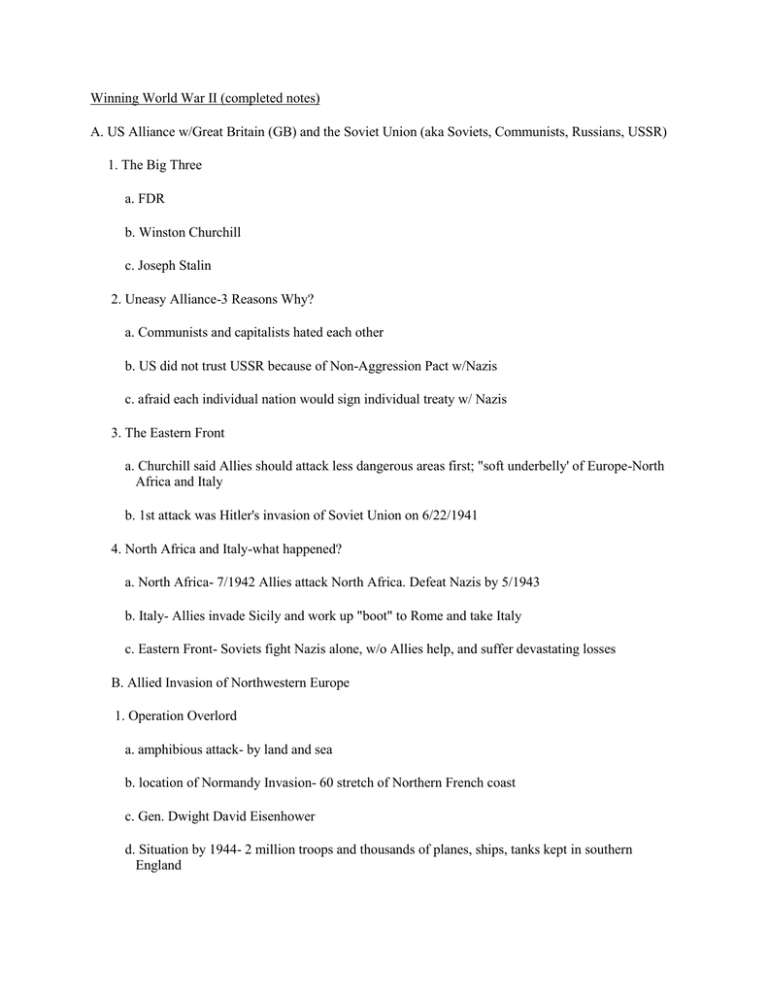
Winning World War II (completed notes) A. US Alliance w/Great Britain (GB) and the Soviet Union (aka Soviets, Communists, Russians, USSR) 1. The Big Three a. FDR b. Winston Churchill c. Joseph Stalin 2. Uneasy Alliance-3 Reasons Why? a. Communists and capitalists hated each other b. US did not trust USSR because of Non-Aggression Pact w/Nazis c. afraid each individual nation would sign individual treaty w/ Nazis 3. The Eastern Front a. Churchill said Allies should attack less dangerous areas first; "soft underbelly' of Europe-North Africa and Italy b. 1st attack was Hitler's invasion of Soviet Union on 6/22/1941 4. North Africa and Italy-what happened? a. North Africa- 7/1942 Allies attack North Africa. Defeat Nazis by 5/1943 b. Italy- Allies invade Sicily and work up "boot" to Rome and take Italy c. Eastern Front- Soviets fight Nazis alone, w/o Allies help, and suffer devastating losses B. Allied Invasion of Northwestern Europe 1. Operation Overlord a. amphibious attack- by land and sea b. location of Normandy Invasion- 60 stretch of Northern French coast c. Gen. Dwight David Eisenhower d. Situation by 1944- 2 million troops and thousands of planes, ships, tanks kept in southern England 2. D-Day begins- June 6, 1944 a. threefold attack 1) army-soldiers landing on beach 2) aircraft-air support from bombers 3) navy-ships bombing the Normandy coast from the English Channel b. Calais, France c. troops carried 50 lbs. of gear into rough and deep surf, beaches filled w/ landmines, constant German machine gun fire d. Allies push through coast and take Paris; begin march toward Belgium and Hitler's Germany C. Battle of the Bulge 1. Allied ground troops moving toward Germany, heavy bombing of Nazis along the way 2. Soviets take Poland and push west towards Berlin, Germany 3. Summary of Battle of the Bulge a. Hitler's last offensive battle b. 14 German divisions surprise and surround Allied forces at Ardennes c. Germans attack at dawn with 2,000 pieces of artillery-create "bulge" in Allied line d. 200,000 Allied reinforcement troops arrive and push Germans back 4. Who won? Allies 5. Significance of Remagen Bridge- only remaining bridge across the Rhine River; allowed access to Berlin D. Allied Victory in Europe 1. Fall of Berlin and death of Hitler a. Hitler obsessed with defeating Allies in the West b. Yalta Conference 1) Feb. 1945 2) discussion- "Big Three "plans for post-WWII Europe, conditions of German surrender c. Hitler at the end of the war- Hitler marries longtime girlfriend Eva Braun, both commit suicide 4/29/1945 2. Victory in Europe a. unconditional surrender by- Hitler's successor signs Nazi surrender to Allies on 5/7/1945 b. V-E Day 1) Victory in Europe 2) 5/8/1945 c. conditions of the Nazi Death Camps- some prisoners still alive, diseased and in shock, appeared like living skeletons, dead massed in piles E. US Strategy in Pacific War 1. Early Japanese Victories a. Areas attacked and taken by Japanese- Philippines, Guam, Burma, Hong Kong, Malaya, Thailand, Wake Islands, Gilbert Islands b. Situation in the Philippines 1) US Gen. Douglas MacArthur 2) American forces suffer huge losses due to combat, malaria and the Japanese blockade of island. US troops surrender. MacArthur promises "I shall return." 3) Bataan Death March- Japanese forced 70,000 American and Filipino troops to walk 60 miles to prison camp. 14,000 die on Bataan Death March. 2. "Island Hopping Strategy" and Attack of Japan a. By spring of 1942, Japan occupied- key portions of Asian mainland and almost every island in over 4,500 miles of Pacific Ocean b. definition of "Island Hopping"- US will attack Japan on selected, less defended islands and "hop' over others to conserve US resources c. "Island Hopping" proved key to US success in the Pacific War 3. The Doolittle Raid a. Tokyo, Japan's capital, and other key Japanese cities b. Doolittle's bombers dropped 500 lb. bombs on Japan c. Doolittle's Raid boosted US morale and deeply shocked Japanese-first time Japan was attacked F. Turning Point of the Pacific War 1. Importance of controlling air and sea a. who had the advantage? - the side with the greatest sea and air power. Not clear in early 1942 who had the advantage, Japan or US. 2. Battle of the Coral Sea a. 5/7 and 5/8/1942 b. unique about battle- battle of aircraft carrier based fighters and bombers-neither side could see the enemy from aboard the carriers c. Japanese losses in the defeat- Japanese lost many aircraft and 2 vital aircraft carriers 3. Battle of Midway a. June 3-5/1942 b. US military leader- Admiral Chester Nimitz c. US had 76 ships to Japan's 162 ships d. Outcome of Battle of Midway- military intelligence intercepted and decoded Japan's secret plan for attack on Midway Japanese made a successful first strike, but Americans took them by surprise and fought back Japanese lost 4 carriers US wins and gets advantage for the first time in Pacific- "tide had begun to turn" G. Battle of Iwo Jima 1. Difficult Island Campaigns a. Territories captured by US in 1943 and 1944- Guadalcanal, Tarawa, Marshall and Marianas Islands b. dangers on islands- malaria, 115 degree heat in the shade, earthquakes, monsoons, razor-sharp coral, "bugs, sweat, and blood" 2. Details of the Battle of Iwo Jima a. dates- Feb.-March 1945 b. description of Iwo Jima- a 4 mile long, 2 mile wide, blackened, burnt volcanic island, off the southern coast of Japan c. fighting conditions on the island1) 23,000 Japanese to 250,000 US troops 2) Japanese controlled steep cliffs, elaborate tunnel system and 1,500 caves 3) land mines on the beaches 4) Japanese committed to bushido (no surrender) d. Outcome of Battle of Iwo Jima- Japanese held out for 4 weeks, Japanese surrender 3/26/1945, only 1,000 Japanese survive, US troops suffer more than 22,000 casualties and 5,300 deaths 3. Okinawa and the Philippines a. by 6/1945 US forces captured Okinawa and reclaimed Philippines b. Next move by US?- US was now ready to attack main islands of Japan
